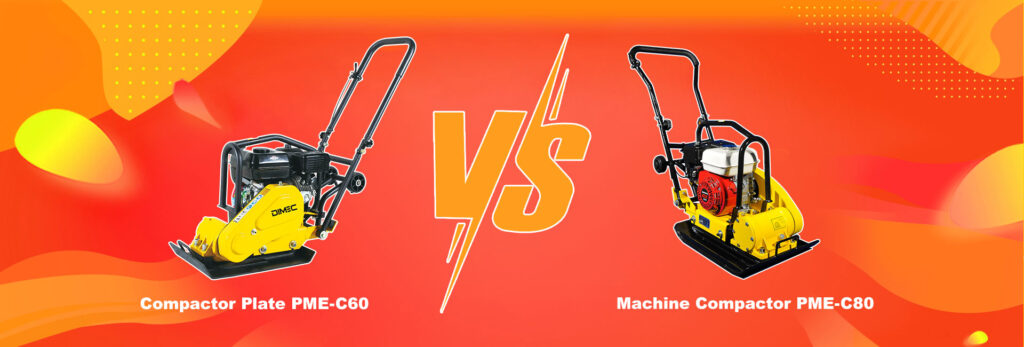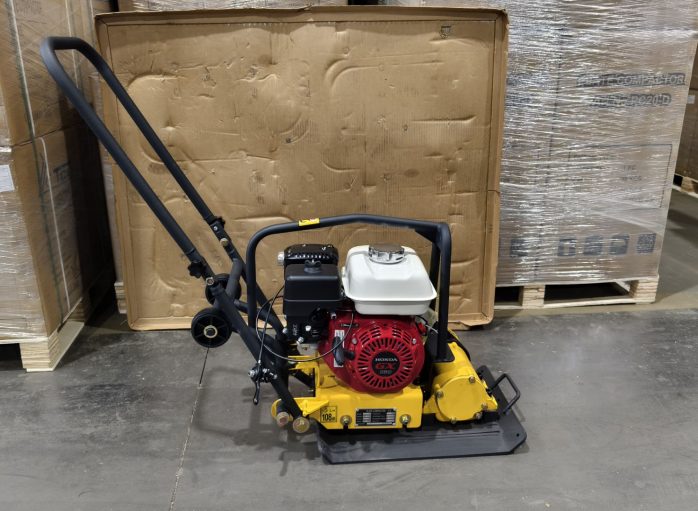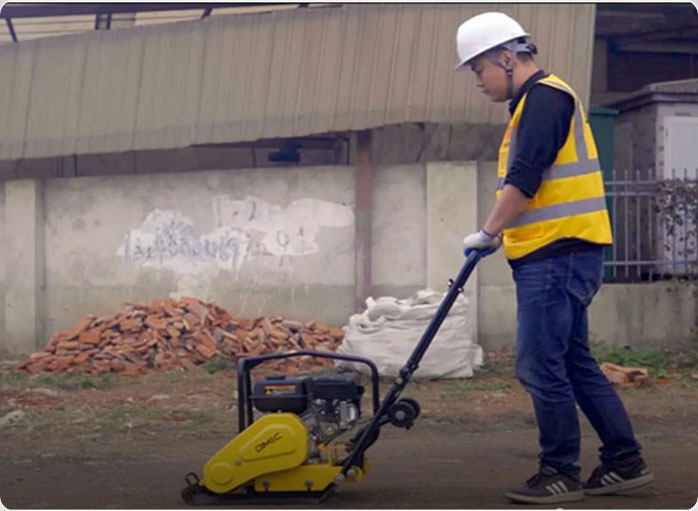2. Product Profiles
2.1 Compactor Plate PME-C60
The Compactor Plate PME-C60 is a compact yet versatile piece of equipment. Its cast-iron base plate is not only robust but also serves as a stable foundation for efficient compaction. The dimensions of the plate are carefully engineered to ensure effective coverage in medium-sized areas.
Power Source and Efficiency
Powered by either a petrol or diesel engine, the PME-C60 offers flexibility in fuel selection. The engine is built for reliability, delivering consistent power for medium-intensity compaction tasks. It’s fuel-efficient, making it an economical choice for projects with budget constraints.
Maneuverability
Weighing [N.W./G.W. 65/70kg], the PME-C60 is lightweight and easy to transport. Its compact design allows it to access tight spaces with ease, making it a popular choice for residential and small-scale commercial projects where space is limited.
2.2 Machine Compactor PME-C80
The Machine Compactor PME-C80 is a heavy-duty workhorse designed to tackle large-scale and demanding projects.
High-Performance Engine
Equipped with a powerful engine, the PME-C80 generates a significantly higher power output compared to the PME-C60. This extra power enables it to handle tough soil conditions and achieve greater compaction depths.
Enhanced Compaction Features
The PME-C80 features a larger plate size, which increases the contact area with the ground. As a result, it can cover a more extensive area in each pass, reducing the overall time required for compaction. Additionally, its higher vibration frequency further enhances its compaction efficiency.
3. Performance Showdown
3.1 Engine Power and Output
The engine of the PME-C60 provides a stable power supply, making it suitable for standard compaction jobs. However, when compared to the PME-C80, the power disparity is clear. The PME-C80’s engine delivers a much higher horsepower, allowing it to work more efficiently on large-scale projects. For example, in a large-scale industrial site development, the PME-C80 can complete compaction tasks in a fraction of the time it would take the PME-C60.
3.2 Plate Size and Compaction Force
The plate size of the PME-C60 is optimized for medium-sized areas. It strikes a good balance between precision and coverage. Conversely, the PME-C80’s larger plate not only covers more ground but also exerts a greater compaction force. This makes the PME-C80 ideal for projects that demand deep and uniform compaction, such as highway construction or large-scale infrastructure development.
3.3 Operational Speed and Productivity
The PME-C60 operates at a speed that is suitable for precise and controlled compaction. Moving at [travel speed 25m/min], it ensures a uniform compaction process. In contrast, the PME-C80 can operate at a higher speed, [travel speed 25m/min], covering more ground in less time. This increased speed, combined with its larger plate size, significantly boosts its productivity on large-scale projects.
4. Application-Specific Suitability
4.1 Ideal Projects for Compactor Plate PME-C60
- Residential Construction: The PME-C60 is perfect for tasks like building small driveways, patios, and backyard walkways. Its compact size allows it to work in tight spaces around homes without causing damage to surrounding structures.
- Small-Scale Commercial Projects: For small businesses looking to create or renovate outdoor areas, such as small parking lots or loading docks, the PME-C60 provides a cost-effective and efficient solution.
- Soil Types Requiring Gentle Compaction: In areas with soft or sandy soils that don’t need excessive force for compaction, the PME-C60 can achieve the necessary compaction levels while maintaining a high level of precision.
4.2 Ideal Projects for Machine Compactor PME-C80
- Large-Scale Infrastructure Projects: The PME-C80 is the go-to machine for highway construction, airport runway development, and large-scale commercial building projects. Its high-power engine, large plate size, and deep compaction capabilities ensure a stable and long-lasting foundation.
- Industrial Site Development: When creating large industrial sites, the PME-C80 can quickly and effectively compact the soil over large areas, reducing the overall project timeline.
- Hard and Compacted Soil Conditions: In areas with hard or compacted soils, the PME-C80’s superior power and compaction force can break through the tough soil layers and achieve the required compaction depth.
5. Operational Considerations
5.1 Ease of Use and Operator Comfort
The PME-C60 is designed with user-friendliness in mind. Its simple control panel and low-vibration design make it easy to operate, even for those with little experience. Operators can work for extended periods without experiencing excessive fatigue. The PME-C80, despite its larger size and higher power, also incorporates ergonomic features. The controls are well-placed and easy to reach, and the shock-absorption system minimizes vibrations, ensuring a comfortable working experience.
5.2 Maintenance Requirements
Regular maintenance is crucial for both machines to ensure they perform at their best. The PME-C60 has a relatively simple design, making maintenance tasks such as oil changes, air filter cleaning, and plate inspections straightforward. The PME-C80, while more complex due to its larger components and high-performance engine, comes with a comprehensive maintenance manual. Regular checks of the engine, plate, and other components are necessary to keep the machine in top condition.
5.3 Cost-Benefit Analysis
The PME-C60 has a lower initial cost, making it an attractive option for small-scale projects with limited budgets. Its fuel efficiency and low maintenance requirements further contribute to its cost-effectiveness. However, for large-scale projects, the PME-C80 offers better long-term value. Although it has a higher upfront cost, its ability to complete projects more quickly and efficiently can result in significant savings in terms of labor costs and project timelines.
6. Conclusion
In conclusion, the decision between the Compactor Plate PME-C60 and Machine Compactor PME-C80 depends on the scale, nature, and requirements of your project. If you’re working on small-scale projects with limited space and budget, the PME-C60 is the ideal choice. Its compact size, maneuverability, and cost-effectiveness make it a practical option. However, for large-scale, heavy-duty projects, the PME-C80’s high-power performance, large plate size, and deep compaction capabilities make it the clear winner. By carefully assessing your project needs, you can make an informed decision and ensure the success of your construction or soil compaction project.
7. Frequently Asked Questions
FAQ 1: What is the most significant difference between the PME-C60 and the PME-C80?
The most significant difference lies in their power and size. The PME-C80 has a more powerful engine and a larger plate size, making it suitable for large-scale and heavy-duty projects. The PME-C60, on the other hand, is more compact and suitable for small to medium-sized projects.
FAQ 2: Can the PME-C60 be used for large-scale projects?
Technically, the PME-C60 can be used for large-scale projects, but it may not be the most efficient option. Its smaller size and lower power output mean that it would take a longer time to complete the compaction compared to the PME-C80.
FAQ 3: How often should I perform maintenance on these machines?
For the PME-C60, regular maintenance such as oil changes every [X] hours of operation and air filter cleaning every [X] hours is recommended. The PME-C80, due to its more complex design and higher-power engine, may require more frequent maintenance, with oil changes every [X] hours and more in-depth component inspections at regular intervals.
FAQ 4: Which machine is more fuel-efficient?
The PME-C60 is generally more fuel-efficient, especially for small-scale and medium-intensity projects. Its smaller engine consumes less fuel compared to the PME-C80’s larger, more powerful engine. However, in large-scale projects where the PME-C80’s efficiency in terms of time and productivity is considered, the overall cost-effectiveness may still favor the PME-C80.
FAQ 5: Are there any safety features on these machines?
Both the PME-C60 and the PME-C80 are equipped with safety features. These include emergency stop buttons, protective guards around moving parts, and vibration-dampening systems to reduce operator fatigue and potential injury.





